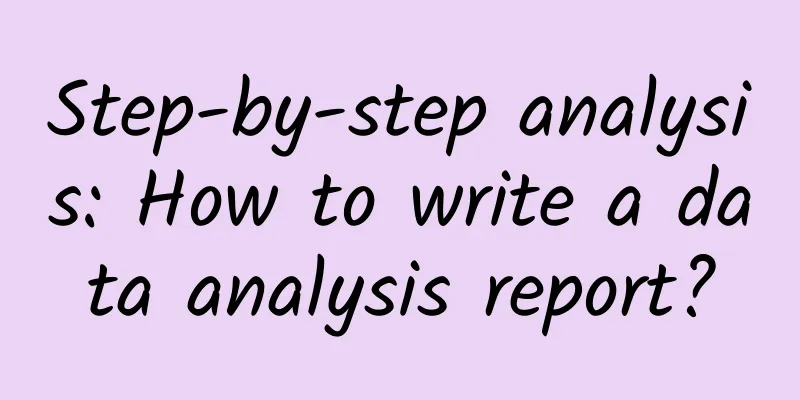Step-by-step analysis: How to write a data analysis report?

|
[51CTO.com Quick Translation] As a data analyst, sooner or later you will need to write a report based on your findings. Obviously, since many people are much more familiar with numbers than words, writing reports becomes the most headache-inducing problem. In addition to templates and tools, we should also look at the entire report writing process from a more fundamental perspective. This is the core of this article - a step-by-step analysis of how to write a data analysis report.
Learn what people don’t know yet In fact, you must be prepared that the audience of your report will not understand what you are trying to express in your report. Translating numbers into words is often difficult and involves multiple disciplines and knowledge systems. But don't worry, we will explain it step by step below. Establish the core objectives of the report First, you need to identify the core objectives of your report and tailor them to the specific circumstances of your audience. Are they simply interested in the results, or do they want to understand how to get to the final conclusion through step-by-step analysis? The specific answer will help you better position your report. Decide on the specific report presentation type The report usually begins with an introductory content (sometimes we will come back to it after the main text is completed), which can be completed in the form of a summary, overview or abstract. Summary introductions are usually aimed at decision makers with clear goals, overview introductions are more general, and abstract introductions are aimed at other data analysts. Note that the format is correct Through various templates, you will find that the actual format of the report varies greatly and each has its own advantages, that is, each is suitable for specific needs, including administrative briefings, letter reports, journal articles or white papers. There is no distinction between good and bad specific formats, everything is based on your needs. Create a draft After choosing the format, the next step is to create a draft report. Here we need to record the various sections, corresponding titles (can be modified at any time) and summarize the general content in a few sentences. This will help everyone understand the workload and complexity, and avoid wasting time on unnecessary topics. Pay attention to the deadline Be aware of the time available to write the report and do everything you can to meet the deadline. Remember, you need to have enough time for editing, proofreading, and delivery in addition to writing the report. You also need to use visualization resources to make your data clearer and easier to understand. All of this needs to be reflected in the time investment. Start writing now Don't expect that the first draft will be passed, so as a first draft, we should pay close attention to the parts related to the meaning of the data, and temporarily ignore grammar, spelling or language style. This is the experience of well-known writers, and it is also worth learning from. Take a break and change your mood Before moving on to the next step, everyone can take a break to change their mindset. If we work for a long time, we may not realize that there is room for improvement. Report Editing Approach your report from a different perspective. Remember, you are not writing your report for yourself, but for a specific audience. They should be able to read your report without having to use Google or a dictionary. So adjust your presentation based on that, and feel free to add in any sections that might make sense to your audience. Include valuable visual resources Without visual assets, there is no analysis report. However, you also need to make sure that all the tables, graphics, and other elements are relevant to the audience. Simply adding visual elements will make it feel unfocused and difficult to understand. Therefore, carefully consider the color and format matching to make those graphics more effective. Report Proofreading Now we start to check the grammar and spelling in the report. Again, you should put the report aside for a few days before checking it again to avoid being influenced by existing ideas. Final Advice: Ask Others to Read Once everything is ready, you should invite others to read the report. It is best to have a specific audience, but it can be anyone else. This way, we can adjust, improve, or add to the content based on their feedback. OK, we are done here, let's submit the report! Original title: How to Write a Data Analysis Report Original author: Janet Anthony [Translated by 51CTO. Please indicate the original translator and source as 51CTO.com when reprinting on partner sites] |
>>: my country will compete for the leading position in 5G communication coding standards
Recommend
TD-LTE wins award: Guarding 5G and leading the world
January 9th was a day of harvest for those who ha...
Why do we need 5G-A?
In today's article, I want to talk to you abo...
10 steps to improve application and network performance
If you work in a network operations team, you kno...
DogYun: Japan Dynamic Cloud 60% off, starting at 0.0457 yuan/hour, Classic Cloud 20% off
DogYun has launched a promotion for Japanese data...
Morphling: How to maximize cost reduction when deploying AI in cloud native?
With the vigorous development of cloud-native tec...
China Radio and Television faces three major challenges on its 5G journey
Since the Ministry of Industry and Information Te...
spinservers: $79/month - 2*E5-2630Lv2, 64G memory, 1.6TB SSD hard disk, 10Gbps bandwidth
spinservers has added a large number of dual E5+S...
IBM acquires Red Hat. Will it be its rival, Google or Huawei? Let's wait and see.
Recently, IBM completed the acquisition of all is...
JuHost: Hong Kong VPS 40% off from $2.99/month, 1GB/20GB SSD/1TB@100Mbps
JuHost was registered in Hong Kong in early 2023,...
80VPS May Promotion: 800 yuan/month-E3-1230/32GB/1TB/8C (232 IPs) cluster server
80VPS is offering a promotion for some cluster se...
JuHost: $2.99/month-1GB/20G SSD/1TB@100Mbps/Kowloon, Hong Kong
JuHost has released a regular November promotion,...
Forgot your switch password? Don’t panic, here are detailed solutions!
It is said that many people are confused about th...
Ten features of IPv6 that are superior to IPv4
It is 2019, and there is a serious problem that b...
VULTR: KVM in 25 data centers around the world starting at $2.5 per month (supports hourly billing), $50 for new users
It has been more than 6 months since I last share...
Top 5 Reasons for WiFi Device Setup and Connection Issues
Setup and connection issues are notoriously diffi...









